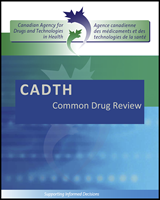Full Population
The submission relied upon pooled patient-level data from the two phase 3 clinical studies to estimate the clinical efficacy of onabotulinumtoxinA in the first 24 months. The primary outcome PREEMPT-1 was the frequency of headache episodesa per 28-day period, which was revised in PREEMPT-2 to the frequency of headache daysb per 28-day period. The results from the intention-to-treat (ITT) population indicated large mean reductions in headache days per 28-day period for both onabotulinumtoxinA and placebo at week 24 (8.4 days and 6.6 days respectively), with statistically significant between-group differences favouring onabotulinumtoxinA.12
Clinical guidelines suggest a 30% to 50% reduction in headache days is a clinically meaningful reduction.18–20 The proportions of patients achieving this mark for the full HC indication were not reported. It is unclear how these proportions were determined, as the results of the studies reported the reduction in headache days as being either 25% or 50%. CDR clinical input indicated that reducing the number of headache days so that the patient is no longer classed as having CM would be at least as appropriate, considering onabotulinumtoxinA has only shown potentially favourable results in the CM population. Patients transitioning from one health state to another are of pivotal importance to the model. The tables below represent an abbreviated transition matrix of ITT patients from the pooled PREEMPT-1 and PREEMPT-2 trials who transitioned between states between weeks 0 and 12 (), and weeks 12 and 24 () in the onabotulinumtoxinA (Botox) group.
Summary of Headache Days for Botox Patients From the Pooled PREEMPT ITT Data (Baseline to Week 12).
Summary of Headache Days for Botox Patients From the Pooled PREEMPT ITT Data (Week 12 to Week 24).
Subpopulation
The pooled PREEMPT study subpopulation (failed three or more oral prophylactic therapies) results reported in the Manufacturer’s Pharmacoeconomic Report4 indicate that the patients treated with onabotulinumtoxinA experienced a greater mean reduction from baseline (7.4 days) in the number of headache days per 28-day period compared with patients receiving placebo (4.7 days).
Clinical guidelines suggest a 30% to 50% reduction in headache days is a clinically meaningful reduction.18–20 The pooled results for the subpopulation in the PREEMPT studies indicate that 57% of onabotulinumtoxinA patients achieved a 30% reduction in headache days at 24 weeks compared with 46% of placebo patients.
and represent transition matrices for the requested subpopulation of patients in the onabotulinumtoxinA (Botox) group from the PREEMPT trials, between weeks 0 and 12 () and between weeks 12 and 24 ().
Summary of Headache Days for Botox Patients from the Pooled PREEMPT Subpopulation Data (Baseline to Week 12).
Summary of Headache Days for Botox Patients from the Pooled PREEMPT Subpopulation Data (Week 12 to Week 24).
- a
A headache episode was defined as consisting of four or more hours of continuous headache as reported per electronic diary.
- b
A headache day was defined as a day when a patient reported four or more continuous hours of headache in the electronic diary.

